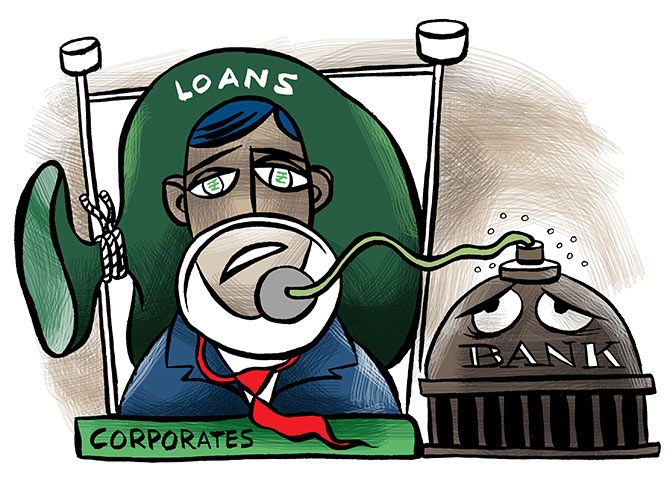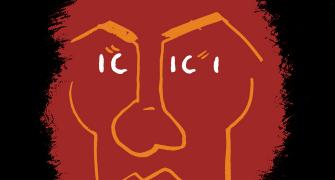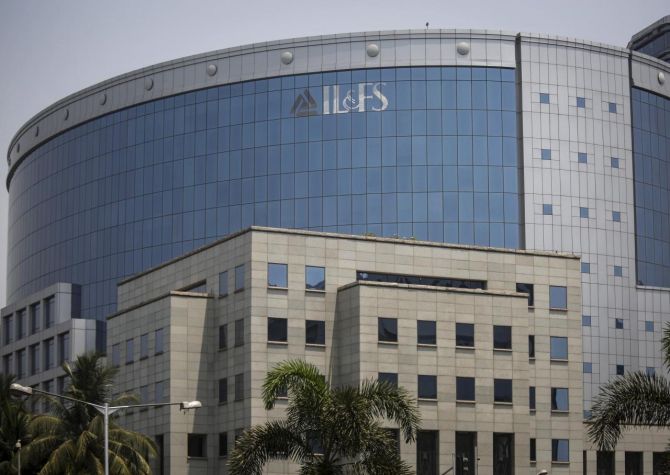While IDBI Bank’s 140 million customers and 1800-odd branches will come in handy for LIC to hawk insurance, the bank can use LIC’s massive agent network to sell its retail loans.
But if it is run the same way it had been in the past and LIC is a proxy of the government, then it has no future, says Tamal Bandyopadhyay.
Illustration: Uttam Ghosh/Rediff.com

Life Insurance Corporation of India’s open offer made for IDBI Bank Ltd has said all provisions of India’s banking act and the Reserve Bank of India (RBI) instructions and guidelines for private banks are applicable to the target company -- positioning IDBI Bank as a private bank.
The RBI, however, continues to classify it in the category of “other public sector banks”.
This creates an existential dilemma for IDBI Bank which is yet to be out of the woods.
For the ninth consecutive quarter, it reported a net loss of Rs 4,185.5 crore for the December quarter, raising the pile of loss close to Rs 28,000 crore since September 2015 when the RBI instituted the first-of-its-kind asset quality review, directing all banks to come up clean by March 2017.
IDBI Bank would have ended up reporting even higher losses for the December quarter but for a Rs 1,620-crore tax write-back.
The last time it had made a net profit was in September 2017 -- Rs 55.52 crore.
To keep it going, LIC, which ramped up its stake to 51 per cent in IDBI Bank in January after completion of the open offer, has infused Rs 21,624 crore in six instalments since September 2018.
How much more will it need to infuse to revive the bank?
Is it a classic case of throwing good money after bad?
Frankly, not everything is bad with IDBI Bank.
In fact, there have been improvements on a few fronts.
The most important of them is the rise in its capital adequacy ratio to 12.51 per cent.
Indeed, it continues to make losses but the provision coverage ratio has risen to 75.21 per cent.
This means the bank has set aside money to cover three-fourths of its bad assets and the recovery of such assets in future will add to its bottomline.
In fact, the key reason behind the stiff loss in December quarter is hefty provisioning.
Its gross bad loans have marginally come down to 29.67 per cent of advances and net bad loans to 14.01 per cent.
An optical illusion of a lower ratio of bad assets gets created when a bank’s advance portfolio grows but IDBI Bank’s advance portfolio has been shrinking.
Another happy sign is that even though the infrastructure sector has at least 18 per cent share in its total loan book, the retail loans now have 48 per cent share in IDBI Bank’s overall loan book, up from 41 per cent two years ago.
During this period, the share of low-cost current and savings accounts or CASA has risen to 38.36 per cent of the deposits, from 36.14 per cent.
If the momentum continues, IDBI Bank should be out of the so-called prompt-corrective action or PCA framework of RBI in next two quarters -- a quarantine which restrains banks from many of their activities.
Is it time to celebrate?
In medical parlance, IDBI Bank is probably being shifted from ICU (intensive care unit) to HDU (high dependency unit) when the care required continues to be intense but the nurse-to-patient ratio is diluted.
Theoretically, LIC’s acquisition of IDBI Bank can work wonders for both.
A task force has been created to look into the business synergy of the two.
LIC has, in fact, already started training sessions at IDBI Bank branches across India to sell its insurance products.
Technically, it is called Bancassurance -- an arrangement between a bank and an insurance company, allowing the insurance company to sell its products to the bank's client base.
This partnership is profitable for both as banks earn additional revenue by selling insurance products and insurance companies expand their customer bases without increasing their sales force.
While IDBI Bank’s 140 million customers and 1800-odd branches will come in handy for LIC to hawk insurance, the bank can use LIC’s massive agent network to sell its retail loans.
Also, LIC has a big pool of long-term money which IDBI Bank can dip into for project loans, if it wants to continue with its legacy.
In future, LIC could also merge its mortgage unit with the bank whose home loans account for 11.50 per cent of the total loan book.
All these are possible, theoretically.
But LIC doesn’t have any experience in running a bank and, had the 55-year old IDBI Bank known this well, it would not have been in this mess.
This means, the bank must be run by a professional management, under the guidance of a competent board.
Barring the entry of a lone director from LIC, the bank’s board has not been reconstructed.
Even though the government stake has come down to 46.46 per cent, the IDBI Bank boss is often seen at the department of financial services in the ministry of finance, New Delhi.
Why should he be there?
The key to success of the IDBI Bank experiment is corporate governance.
If it is run the same way it had been in the past and LIC is a proxy of the government, then it has no future.
Rakesh Sharma, who took over as MD and CEO, of the bank in mid-October 2018 is just about a fortnight away from his retirement.
His predecessor B Sriram, a former MD of State Bank of India, had a three-month stint.
Such short tenures of the CEO of the bank at such a critical juncture doesn’t smack of seriousness.
LIC is required to bring down its stake to 40 per cent by December 2031.
Twelve years is a long time but whether it’s a profitable investment for LIC will depend on how it runs the bank.
In April 2001, the Munich-based insurance firm Allianz SE bought Dresdner Bank AG for at least €20 billion, making it the most important deal of the year, marrying banking, investment banking and insurance.
The idea was to exploit the synergy between the two.
But Dresdner’s €35.5 billion problem loans and cultural issues played the spoilt sport.
The projected synergies never materialised; in August 2008, Allianz sold Dresdner Bank to Commerzbank AG for €9.8 billion.
By that time, Dresdner Bank had lost more than half its value.
It’s another story that nothing much is left for IDBI Bank to lose.
In his February 2016 Budget speech, Finance Minister Arun Jaitley had spoken about the transformation of IDBI Bank: “The process of transformation of IDBI Bank has already started.
"[The] government will take it forward and also consider the option of reducing its stake to below 50 per cent.”
Let’s watch how the transformation unfolds.
Tamal Bandyopadhyay, a consulting editor of Business Standard, is an author and senior adviser to Jana Small Finance Bank Ltd.










